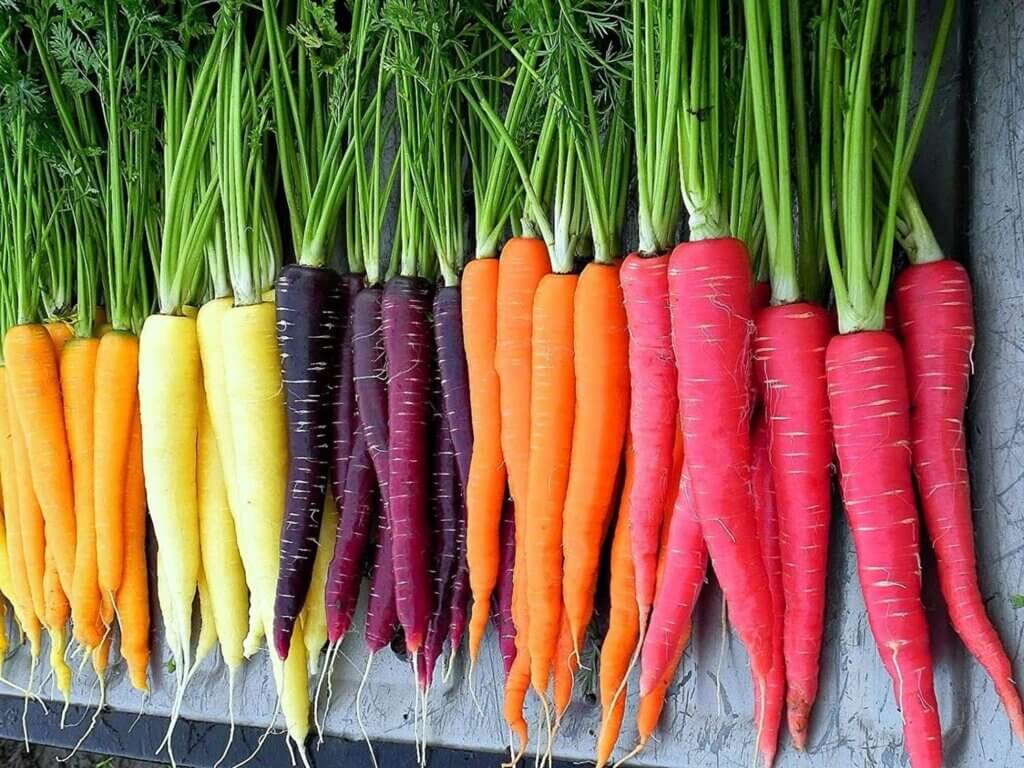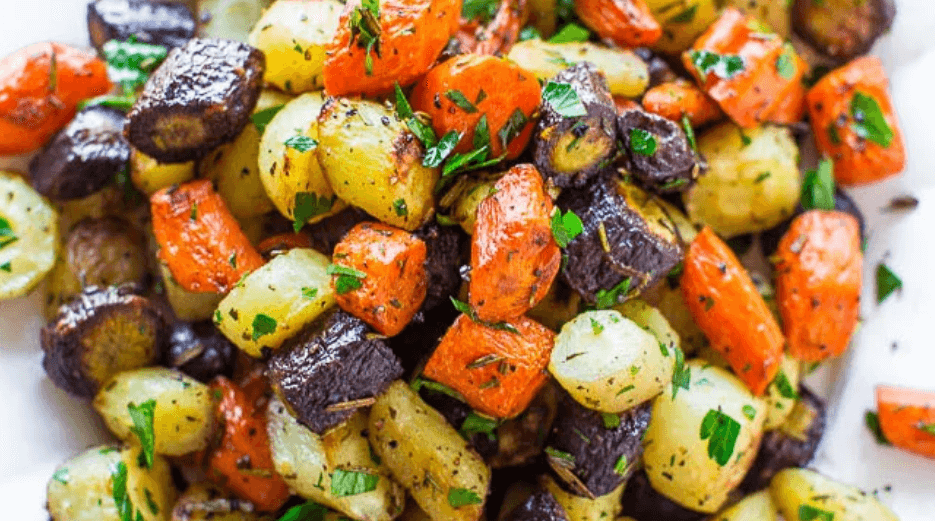Written by Andrew Akhaphong, MS, RD, LD, Mackenthun’s Registered Dietitian
Updated January 10, 2025
Carrots are a root vegetable known for its identifiable orange color and green leafy tops; however, can also be found as “babies” for easy snacking on-the-go.
The Packer’s Fresh Trends 2024 reports 60.9% of consumers are buying carrots which is an increase from 50% in 2023 and 51% in 2022.(1) Persons ages 60-years and older are the frequent buyer of carrots (70.7%) with persons between 18 to 29-years of age at 46.9%.
Move over “orange carrots” as there is room for rainbow carrots to grow, too! Rainbow carrots, though cost more than their orange counterparts, are increasing in popularity as they provide a pop of color for meals and snacks.
What Are Rainbow Carrots?
As the name suggests, each bunch or package of rainbow carrots provides you a variety of colors including shades of orange, yellow, purple, red, and white!
Carrots are native plants to the Middle East, primarily Afghanistan, Iran, and Pakistan. According to botanists, history reports wild carrots were white in color, but also undesirable at the time as they were considered weeds. Through breeding programs color varieties such as purple, yellow, and red came first. It was not until the 1400s-1500s the orange carrot came into existence! (2)
Each color variety also has uniquely different flavors too which can elevate your meal or snacking experience!
- Purple – have peppery notes and have a woodier texture
- Red – similar to their orange counterparts which can range from sweet to earthy tones
- Yellow – sweeter than orange carrots with fruity or earthy undertones like potatoes, celery, or parsnips
- White – the sweetest carrot above all (including orange)

Nutritional Benefits
Each color of the rainbow carrot is attributed to nutrients that make up the pigment of the root vegetable.
Purple carrots get their beautiful deep color from the nutrient, anthocyanin. In clinical trials, anthocyanins reduced blood sugar levels, improved HgbA1c, and improved insulin sensitivity.(3,4) Quick tip – if you would like to retain the integrity of anthocyanin avoid boiling, stewing, poaching, or using acid (ie. lemon juice, vinegar, tomatoes, etc.).
Lycopene is a nutrient that gives produce their vibrant red color. If one has issues with tomatoes due to acid reflux, or dislike tomatoes, red carrots can be a great option to get more lycopene! Inflammation is to considered to be a main cause of coronary heart disease. Lycopene has been found to reduce inflammation of the heart and its vessels to support healthy blood pressure levels.(5)
White and yellow carrots contain similar nutrients that give their pigments including zeaxanthins, lutein, anthoxanthins, among others. The intensity of white or yellow tones is dependent on the variety or amount of these nutrients present. Dietary patterns high in lutein and zeaxanthin have been shown to slow progression of age-related macular generation, an eye disorder.(6)
Herb-Roasted Rainbow Carrots
By Averie Sunshine of Averie Cooks, November 21, 2018
What You Need
- 2 pounds carrots, trimmed, peeled, and cut on the diagonal into 1/2-inch pieces (I used tri-colored carrots but you can use all orange)
- 2 tablespoons olive oil
- 2 to 3 teaspoons fresh rosemary, finely chopped
- 1 teaspoon fresh thyme
- 1 teaspoon salt, or to taste
- 1 teaspoon pepper, or to taste
- 2 to 3 teaspoons fresh Italian flat-leaf parsley, finely chopped
- 2 teaspoons lemon juice, optional
What You Do
- Preheat oven to 450F and line a baking sheet with aluminum foil for easier cleanup.
- Add the carrots to the baking sheet, evenly drizzle with olive oil, and evenly sprinkle with thyme, rosemary, salt, pepper, and toss with your hands to evenly coat.
- Arrange the carrots in a flat layer with space between the pieces if possible and bake for about 30 to 35 minutes or until carrots are lightly caramelized around the edges and fork-tender. Baking times will vary based on the size of carrots and personal preference for doneness.
- Stir and flip halfway through baking to ensure all sides cook evenly.
- Evenly sprinkle with parsley, evenly drizzle with optional lemon juice (brightens up the dish), and serve immediately.

References
- The Packer Staff. More consumers report carrot purchases, Fresh Trends survey shows. June 20, 2024. Accessed January 10, 2025. Retrieved from https://www.thepacker.com/news/retail/more-consumers-report-carrot-purchases-fresh-trends-survey-shows
- Iorizzo M, Ellison S, Senalik D, Zeng P, Satapoomin P, et al. A high-quality carrot genome assembly provides new insights into carotenoid accumulation and asterid genome evolution. Nature Genetics. 2016. 48;657-666. https://doi.org/10.1038/ng.3565
- Da Porto A, Cavarape A, Colussi GL, Casarsa V, Catena C, Sechi LA. Polyphenols rich diets and risk of type 2 diabetes. Nutrients. 2021. 13(5):1445. doi: 10.3390/nu13051445.
- Kim Y, Keogh JB, Clifton PM. Polyphenols and glycemic control. Nutrients. 2016. 8(1):17. doi: 10.3390/nu8010017.
- Przybylska S, Tokarczyk G. Lycopene in the prevention of cardiovascular disease. Int J Mol Sci. 2022. 23(4):1957. doi: 10.3390/ijms23041957
- Mrowica M, Mrowicki J, Kucharska E, Majsterek I. Lutein and zeaxanthin and their roles in age-related macular degeneration-neurodegenerative disease. Nutrients. 2022;14(4):827. doi: 10.3390/nu14040827


